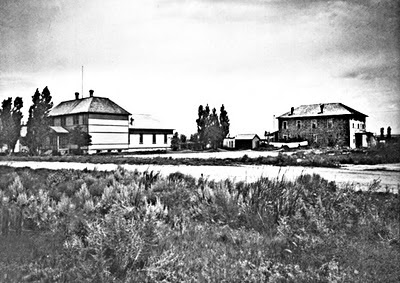 |
| Loyal P. Brown. Historical Museum at St. Gertrude, Cottonwood, Idaho. |
His mercantile experience began when he was 16 years old. After a few years of that, he became a Forty-Niner, traveling the isthmus route to California. He did well in the gold fields, and then with stores he opened in northern California and in Oregon. After a year back East, he returned to Oregon and settled in the Umpqua Valley.
When gold was discovered near Florence, he brought his family to Idaho. In July 1862, they reached the waystation of Mose Milner, near the southeast edge of the Camas Prairie. Sensing opportunity, Brown and a partner purchased what would become Mount Idaho.
Brown, a life-long temperance advocate, disagreed with his partner about building a saloon onto the hotel, so Brown bought him out three years later. The structure then housed a post office, with Brown as postmaster, and a modest store. L. P. also opened a small blacksmith shop. Brown’s holdings grew extensively: many leased lots in Mount Idaho, a grist mill, another store in Elk City, and a substantial ranch. The ranch held “quite a band of cattle” and exported horses into Montana.
 |
| Mount Idaho Courthouse, built in the early 1870s. [Hawley] |
Brown represented Nez Perce County on the 1874-75 Territorial Council. (He had also held that office in 1866-67.) During that session, he worked a bill through the legislature that redrew county boundaries, resulting in the selection of Mount Idaho as the county seat of Idaho County. That fueled even further growth before the Nez Perce War broke out.
L.P. played a major leadership role in the 1877 War: His dispatches provided the first warning of the outbreak to the Army units at Fort Lapwai. He also supplied materials and supervised construction of a hastily-built stockade at Mount Idaho, and provided shelter for all who had to flee their homesteads.
Brown expanded further after the war. Merchants added new structures in Mount Idaho, and he built a steam sawmill northeast of town. Elsewhere, he bought up much of the town of Cottonwood and encouraged its growth: a post office in 1879, a blacksmith shop, and, in 1880, a store and Brown’s own hotel.
During the early 1880s, Brown broadened his holdings even more to include six or seven thousand head of sheep along with his cattle and horses. Of course, he wasn’t the only stockman. On July 20, 1885, ranchers in Idaho County created the Idaho County Stock Growers' Association. (As elsewhere in the state, one of their main concerns was rustling). The Association elected Brown as its first president.
Settlers continued to arrive in the area and, in July and August of 1887, leaders organized the Idaho County Pioneer Association [blog, July 16]. Again, L. P. Brown was its first president.
Brown even found time to invest in Clearwater mining ventures. However, he sold perhaps his most promising lode mine property to a California firm in early 1894. He passed away in April 1896.
| References: [Illust-North] |
| M. Alfreda Elsensohn, Eugene F. Hoy (ed.), Pioneer Days in Idaho County, Caxton Printers, Caldwell, Idaho (1951). |








.jpg)



























